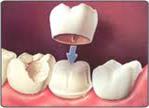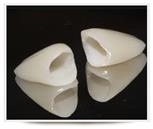
1201 Ocean Parkway
Brooklyn, NY 11230
718-554-7798
Yelena Vaysman
D.D.S
COSMETIC DENTIST
Brooklyn dentist offers crowns made from different dental ceramics and metal ceramic,
At the first appointment, Brooklyn dentist Dr. Yelena Vaysman will prepare the tooth on sides plus the top in order to make room for the crown. This is also when any decay is removed. There often will be a core build up. After the decay is removed, the tooth usually has lost a substantial amount of tooth structure and is in an odd shape. The cost of core build up is charged additional to the crown cost. A core build up is similar to a filling, where the tooth is built up back to attain the most ideal shape to support the crown. The doctor will take an impression, of the tooth which will be sent to an off side dental lab. The lab uses this mold to make an identical model of your tooth, onto which the crown is fabricated. A shade is then selected so the lab knows what color to make the crown. The second appointment of the dental crown procedure involves try in or seating the crown. The try in or final crown is fitted onto the tooth. This normally involves some adjustments, and then the crown is sent to the lab for finishing or it is cemented onto the tooth.
WHY ARE TEETH CROWNED?
Teeth are crowned for a number of reasons... most often being because of INSUFFICIENT TOOTH STRUCTURE. IF there is not enough tooth structure to SUPPORT A FILLING, you may need a crown.
WHAT ARE DENTAL CROWNS MADE OF?
CROWNS can be GOLD, PORCELAIN or other tooth colored material, or PORCELAIN FUSED TO GOLD/METAL (PFM/PFG).
WHY NOT GOLD CROWN?
ESTHETICS. In the current day of everyone wanting whiter teeth and looking more natural, gold is esthetically less acceptable, unless it is in the back of your mouth.
NON METAL CROWN vs. PORCELAIN FUSED TO METAL?
Like gold, the metal hardness is closer to that of natural tooth structure, so part of the tooth can be PORCELAIN (for esthetics) and part of it can be metal/gold (part that hits the opposing tooth). The metal is normally an alloy of gold, with the amount of gold and other metals varying depending on the type of crown.
Because of the metal substructure, the esthetics of PFM crowns can be close to your natural tooth, but not normally as good as the following options.
Layered Zirconia crowns are like PFM crowns, except the metal substructure is primarily cubic zirconia, which has a white appearance rather than a silver or gold appearance. This allows for much better esthetics, but may still not be suitable for all posterior teeth under high stress.
Solid Zirconia crowns suitable for all posterior teeth under high stress.
WHY PORCELAIN OR ZIRCONIA CROWN?
ESTHETICS. Full porcelain crowns look very good and natural, but they do not tend to hold up too well in the posterior region. In the anterior region, if they are not subjected to too much force, they should be ok.
When porcelain crowns are done, the preparation phase of the dental crown procedure requires more tooth structure to be removed in order to make room for the porcelain on porcelain crowns.
There are several tooth colored crowns like ZIRCONIA or IPS e.max crowns that are stronger than porcelain but offer similar esthetics.
Yes, crowns are expensive, but if it is not done and the tooth fractures, it is possible that that tooth may be lost


DENTAL CROWNS BROOKLYN.
,
DENTAL CROWNS, PORCELAIN CROWNS, ZIRCONIA CROWNS.
718-554-7798